Pallet Inverter: How to Reduce Breakage When Rotating Glass Bottle Pallets?
Handling pallets of glass bottles can be a stressful part of any operation. You see your team carefully moving a pallet, and then you hear that faint, sharp clinking sound. It's the sound of breaking glass, which means lost product, wasted time, and shrinking profits. This isn't just about the cost of the broken bottles. It’s also about the time your team spends cleaning up a dangerous mess, the delays it causes in your production line, and the risk of injury. This constant small loss is a headache that slowly eats away at your bottom line. What if there was a way to rotate an entire pallet of glass bottles with complete control and precision, making breakage a thing of the past? A pallet inverter is the specialized solution designed to solve this exact problem.
To reduce breakage when rotating glass bottle pallets, you must use a pallet inverter with an adjustable and gentle clamping pressure system. This machine securely holds the entire load from both the top and bottom before it begins to rotate. This controlled 180-degree rotation prevents the individual bottles from shifting or knocking against each other, which is the main cause of damage when you try to handle them manually or with the wrong equipment.
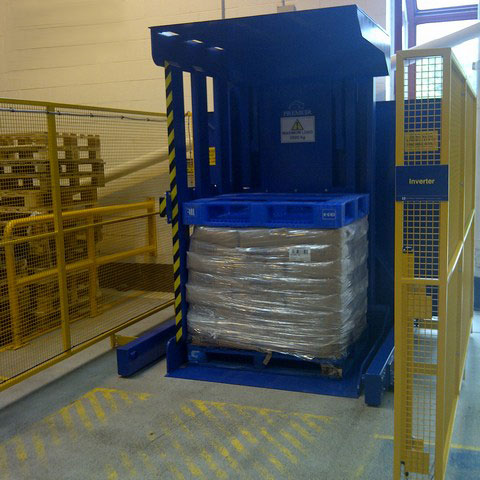
I understand that thinking about new equipment can seem complex. You might be wondering if it's just another machine to maintain. But from my own journey, from an engineer on the factory floor to owning my own business, I've learned to see the difference between an expense and an investment. A pallet inverter is a true investment in efficiency and quality. Let’s explore how this technology works and why it is so effective for anyone handling fragile goods.
What is a pallet inverter and why is it crucial for fragile goods like glass bottles?
Imagine you have a full pallet of glass bottles, but the pallet at the bottom is damaged. Or maybe you need to switch the load to a plastic pallet for hygienic reasons before shipping. The old way to do this is to have your workers restack the entire pallet, bottle by bottle. This manual process is incredibly slow, requires a lot of labor, and is filled with risk. Every single time a bottle is picked up, it's a new opportunity for it to be dropped, chipped, or cracked. This creates a major bottleneck in your workflow and is a significant source of product loss. A pallet inverter is designed to solve this by mechanizing the entire process. It clamps the load securely, rotates it smoothly, and allows you to exchange the pallet in just a couple of minutes, not hours, with almost no manual handling.
A pallet inverter is a piece of material handling equipment that securely clamps a palletized load and rotates it 180 degrees. For fragile goods like glass bottles, it is absolutely crucial because it gets rid of the need for manual restacking. By keeping the bottles perfectly contained and stable during the entire rotation, it prevents the impacts and vibrations that cause breakage.
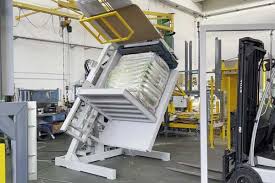
How a Pallet Inverter Works
The process is simple and very effective. It’s an engineered solution that brings control to an otherwise chaotic task. I've seen it transform warehouse operations time and time again. The machine itself consists of two strong clamping platforms, a powerful hydraulic system to provide pressure, and a robust mechanism for rotation.
Here is the step-by-step process:
- A forklift operator places the full pallet onto the inverter's bottom platform.
- The top platform lowers and applies a controlled, even pressure across the top of the load.
- The machine's rotation system then turns the entire clamped load a full 180 degrees.
- The original pallet, which is now on top of the inverted load, can be easily lifted off by the forklift.
- The new, replacement pallet is placed on top of the load.
- The machine rotates back 180 degrees to its starting position. The load is now sitting securely on the new pallet, ready to be moved.
Why This Matters for Glass Bottles vs. Other Goods
Not all products are the same, and the way you handle them shouldn't be either. The controlled process of a pallet inverter is what makes it so valuable for delicate items. For a pragmatic business leader, understanding this distinction is key to appreciating the machine's value. It provides the production stability you need by minimizing unexpected product loss and disruptions.
| Product Type | Key Challenge | How a Pallet Inverter Helps |
|---|---|---|
| Glass Bottles | Brittle, fails on sharp impact. Stack can become unstable if one layer shifts. | Wide clamping plates distribute pressure evenly, preventing point loading. The entire stack is kept perfectly aligned. |
| Canned Goods | Dents can compromise product integrity. Prone to shifting. | Secure clamping prevents cans from shifting and denting against each other. It maintains the original stacking pattern. |
| Steel Coils | Extremely heavy and dense. Safety is the top priority. | While different machinery is used, the principle of secure handling to prevent accidents and damage is the same. Control is key. |
How does a pallet inverter's clamping pressure system prevent glass bottle breakage?
The idea of clamping a pallet stacked high with fragile glass bottles can sound like a bad idea. If you use too little pressure, the entire load could shift and collapse during rotation. But if you use too much pressure, you could crush the very product you are trying to protect. This is a real concern. If your team gets the pressure wrong, you could turn a pallet of valuable inventory into a very expensive pile of broken glass. This fear can even make operators hesitant to use the machine, defeating its purpose. The solution is in the technology. Modern pallet inverters do not have a simple on/off clamping function. They use advanced, highly adjustable hydraulic pressure systems that let you set the exact amount of force needed for your specific product.
A pallet inverter's clamping pressure system prevents breakage by applying just enough force to secure the load without causing any damage. This is done using an adjustable hydraulic pressure relief valve. Operators can set a specific, low pressure for delicate items like glass bottles. This ensures the load is held firmly but gently through the entire 180-degree rotation.
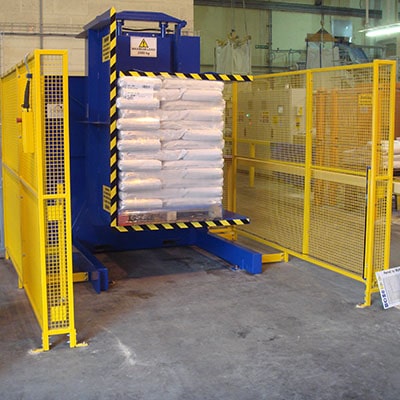
The Science of "Just Right" Pressure
From my engineering background, I can tell you that the beauty of this system is in its precision and repeatability. It removes all the guesswork. The operator sets the pressure using a simple valve and confirms it on a pressure gauge. This value can be recorded in your standard operating procedures, so every operator uses the exact same setting for the same product, every time. This is how you achieve consistency and quality control.
Another key design feature is the large, flat surface of the clamping platforms. These plates distribute the clamping force over the entire top and bottom surface area of the load. This avoids creating "pressure points," which could concentrate force on a single bottle or area and cause it to crack. It’s a much safer and more controlled method than trying to use a forklift with a clamp attachment, which applies pressure on the sides and has a much smaller contact area, making it far too risky for glass.
Critical Factors for Setting Clamping Pressure
To achieve perfect results, you need to consider a few factors when setting the pressure. This methodical approach will be very familiar to any engineer or manager focused on process optimization.
| Factor | Why it Matters for Glass Bottles | My Recommendation |
|---|---|---|
| Total Load Weight | A heavier load has more inertia, meaning it requires slightly more pressure to hold it steady during rotation. | Always start with a low pressure setting and perform a test rotation. Calibrate the pressure based on your heaviest standard pallet configuration. |
| Product Packaging | Strong cardboard boxes with internal dividers provide a lot of structural support. A pallet held together only by shrink-wrap is much less stable. | Consider the packaging. A well-boxed pallet can handle more pressure than one that is loosely wrapped. The pressure setting should match the packaging type. |
| Stacking Pattern | An interlocking stacking pattern is far more stable than a simple column stack. A stable load requires less clamping force. | If possible, standardize your stacking patterns for fragile goods. This allows you to set the pressure once and not have to adjust it constantly. |
| Machine Speed | A faster rotation creates more force and requires more clamping pressure to prevent any movement. | For fragile goods like glass bottles, always use a slow and smooth rotation speed. The goal is safety and quality, not speed. |
What are the critical operational steps for safely rotating glass bottle pallets?
So, you have invested in a new pallet inverter. The machine is installed on your factory floor, but your team still seems nervous about using it. They see a large, powerful machine and a pallet of fragile glass, and they are worried about making a mistake that could cause a mess or an accident. This is a common situation. Improper operation can lead to the very breakage you wanted to prevent, or even worse, a safety incident on the floor. This can completely undermine your investment. The key to building confidence and ensuring success is to have a clear, simple, and repeatable process. By training your team to follow a checklist for every single use, they can operate the pallet inverter with confidence and get perfect results every time.
The critical operational steps for safely rotating glass bottle pallets are: 1) inspect the pallet for any instability before you load it, 2) load the pallet so it is sitting squarely in the center of the inverter, 3) set the correct, low clamping pressure for glass, 4) make sure all safety guards and light curtains are active, and 5) use a slow, controlled rotation speed. Following this exact sequence is the best way to minimize all risks and prevent product damage.
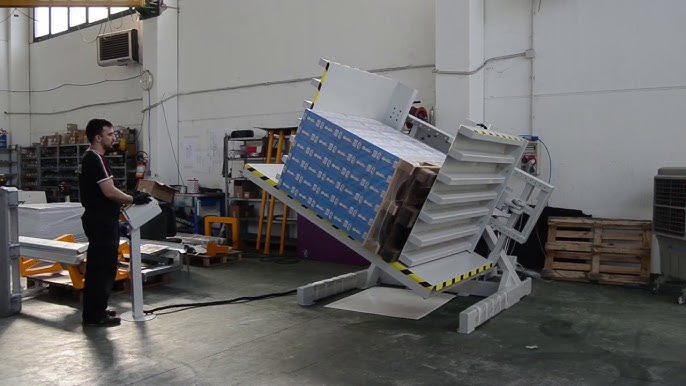
Pre-Operation Checklist
Success starts before you even turn the machine on. A few seconds of inspection can prevent a major problem. In my factory, we learned that the hard way. Now, a pre-use check is mandatory.
- Inspect the Load: Before you even think about moving the pallet, take a good look at it. Is the stack leaning? Is the shrink wrap torn or loose? Are there broken boards on the pallet itself? You should never put a pallet with existing problems into the machine and expect a perfect outcome. Fix the issue first.
- Check the Machine: Do a quick visual check of the clamping platforms. Make sure they are clean and free of any debris. A stray piece of wood, a rock, or a metal scrap left on the platform can become a pressure point and crack a bottle during the clamping phase.
The 5-Step Safe Rotation Process
This simple process should be your standard operating procedure (SOP). It ensures safety and quality.
- Centering the Load: This is extremely important. The pallet must be placed in the center of the bottom platform. An off-center load will be unbalanced, creating uneven forces and stress on both the load and the machine during rotation. I recommend painting guide-lines on the floor and the machine to make centering easy and fast.
- Setting the Pressure: This step should not be a guess. As we discussed, the correct pressure should be determined and recorded in your SOP. The operator should simply set the pre-determined value on the gauge.
- Engaging Safety Features: Modern pallet inverters are equipped with safety features like steel mesh cages, light curtains that stop the machine if a person gets too close, and emergency stop buttons. These are not optional. They must be checked and active before every cycle. This protects your people and your investment.
- The Rotation Itself: The operator should use the controls to start the rotation slowly and smoothly. The hydraulic systems in these machines allow for very gentle starts and stops. Avoid any sudden, jerky movements which can send a shockwave through the stack of glass.
- Post-Rotation: After the pallet has been exchanged and the load is back in its original position, do one last quick visual inspection before the forklift takes it away. This confirms that the job was done correctly.
Beyond breakage, what other ROI benefits does a pallet inverter offer a business like yours?
You now have a clear understanding of how a pallet inverter can prevent the breakage of fragile goods like glass bottles. But I know that for a business leader like you, a major equipment purchase needs to be justified by more than just solving one problem. It's a significant capital investment. You have to be able to show a clear return on that investment that goes beyond just saving a few broken bottles. In a business with tight margins and constant cost pressures, every dollar must be accounted for and deliver a strong return. If a machine only solves one small issue, it can be very hard to get the investment approved. The real value of a pallet inverter is its broad impact on your entire operation, from labor costs to overall efficiency and worker safety. The ROI is not just in the product you save, but also in the time you gain, the injuries you prevent, and the logistics you streamline.
Beyond just reducing breakage, a pallet inverter delivers a significant return on investment (ROI) by dramatically increasing your operational efficiency, improving worker safety, and helping you optimize your warehouse space. It completely automates the slow, dangerous, and manual process of pallet swapping. This frees up your valuable labor to work on more important, value-added tasks and greatly reduces the risk of expensive back injuries.
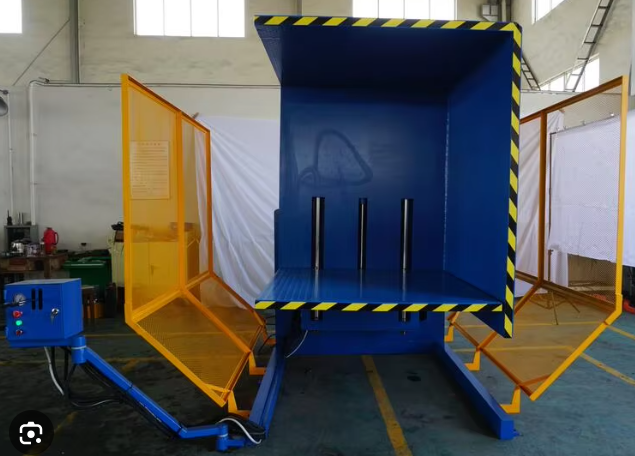
Quantifying the Efficiency Gains
As an engineer and factory owner, I always want to see the numbers. The difference between the manual method and using a pallet inverter is not small; it's a game-changer for your operational metrics. This is how you can directly address goals like improving capacity utilization and lowering costs.
| Table: Pallet Exchange Analysis | Metric | Manual Pallet Exchange | Pallet Inverter Exchange | Impact on Your Goals |
|---|---|---|---|---|
| Time per Pallet | 20-30 minutes | 1-2 minutes | Massively increases Capacity Utilization by removing a major labor bottleneck from your process. | |
| Labor Required | 2 workers | 1 worker (the forklift operator) | Significantly lowers Operating Costs by reducing the labor needed for this specific task by over 50%. | |
| Product Loss Risk | High (can be 5% or more) | Extremely Low (less than 0.1%) | Directly improves your Profit Margin by nearly eliminating this source of waste and product loss. | |
| Injury Risk | High (back strain, cuts from broken glass) | Very Low | Reduces hidden costs from accidents, like worker compensation claims and lost time. |
Aligning with Strategic Goals
A pallet inverter is more than just a tool. It's a piece of modern automation that can help you achieve your larger strategic objectives.
- Digitalization and Automation: This machine is a clear step away from inefficient manual labor and toward a more automated, streamlined warehouse. It’s a stand-alone solution that can also be integrated into larger automated systems with conveyors. This directly supports your goal of a Digitalization Transformation by replacing an analog process with a controlled, mechanical one. Some advanced models can even be equipped with sensors to log cycle times and other data, feeding it directly into a Manufacturing Execution System (MES).
- Cost Reduction: The financial argument is very clear. When you combine the savings from less product waste, reduced labor hours for this task, and fewer workplace injuries, you get a direct and measurable reduction in your Overall Operating Costs. This is exactly the kind of efficiency gain that helps you reach an ambitious goal like an 8% cost reduction.
- Sustainability and Environmental Compliance: This is an increasingly important issue for all industries. By reducing breakage, you are also reducing the amount of glass and packaging waste that has to be disposed of. This is a real, tangible contribution to your sustainability goals and helps you address the Environmental Pressure from regulations. It's a smarter, cleaner, and more responsible way to operate.
My Insights
When I took the leap and started my own factory, money was tight. Every single purchase, no matter how small, was a huge decision. I remember looking at a new piece of equipment, something like a pallet inverter, and thinking to myself, "This is a lot of money. Can I really afford this right now?"
My old boss, who became a great mentor to me, saw me struggling with the decision. He pulled me aside and said something I've never forgotten. "Vincent," he said, "don't ask if you can afford to buy it. Ask yourself what it's costing you not to have it."
That simple question completely changed my way of thinking. I went back to my office and started to calculate the real cost of our inefficiency. The cost of the products we damaged every single day. The cost of having two workers tied up for half an hour on a task that one machine could do in two minutes. The hidden cost of a potential back injury that could put an employee out of work for weeks.
Suddenly, the machine didn't look like an expense anymore. It looked like an investment. An investment that would start paying me back on day one, and continue to deliver value every single day after that.
For a leader like you, Mr. Morales, who has successfully built a major company from the ground up, I know you understand this principle deeply. You have made smart, forward-thinking investments in things like high-efficiency energy systems because you see the long-term strategic value. A pallet inverter works on the exact same principle. It's not just about turning pallets. It's about finding and eliminating a chronic source of loss in your operation. It’s about making your process stronger, your workplace safer, and your business more profitable. It is a strategic move, not just an operational one.
Conclusion
A pallet inverter is more than a machine; it's a strategic tool to reduce breakage, boost efficiency, and increase safety, delivering a clear and rapid return on your investment.



